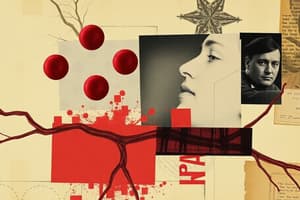Podcast
Questions and Answers
What does formed plasmin degrade fibrinogen or fibrin into?
What does formed plasmin degrade fibrinogen or fibrin into?
- Fibrin degradation products (correct)
- Thrombin
- Clotting factors
- Platelet aggregates
What is the reference range for bleeding time using the Ivy method?
What is the reference range for bleeding time using the Ivy method?
- 1-5 minutes
- 2-8 minutes
- 1-7 minutes (correct)
- 1-6 minutes
Which of the following conditions would NOT likely prolong bleeding time?
Which of the following conditions would NOT likely prolong bleeding time?
- Von Willebrand's disease
- Thrombasthenia
- Normal platelet function (correct)
- Bernard Soulier syndrome
What is the primary role of plasminogen activator inhibitor 1 (PAI-1)?
What is the primary role of plasminogen activator inhibitor 1 (PAI-1)?
Which of the following is a source of false positive in bleeding time assessment?
Which of the following is a source of false positive in bleeding time assessment?
What is the normal reference range for the activated coagulation time?
What is the normal reference range for the activated coagulation time?
What causes the Bernard-Soulier syndrome?
What causes the Bernard-Soulier syndrome?
What is a potential consequence of insufficient endothelial function?
What is a potential consequence of insufficient endothelial function?
Which method is NOT a platelet function test?
Which method is NOT a platelet function test?
What induces endothelial cell activation?
What induces endothelial cell activation?
What does the Ivy Method primarily assess?
What does the Ivy Method primarily assess?
Which component is critical in thrombus formation?
Which component is critical in thrombus formation?
What is the primary purpose of the fibrinolytic system in hemostasis?
What is the primary purpose of the fibrinolytic system in hemostasis?
Which test is used to evaluate the intrinsic pathway of coagulation?
Which test is used to evaluate the intrinsic pathway of coagulation?
What can excessive consumption of platelets lead to?
What can excessive consumption of platelets lead to?
What happens to platelets upon activation by prostacyclin?
What happens to platelets upon activation by prostacyclin?
What is the role of nitric oxide in the hemostatic process?
What is the role of nitric oxide in the hemostatic process?
What protein is deficient in von Willebrand disease (vWD)?
What protein is deficient in von Willebrand disease (vWD)?
Which mechanism do heparin-like molecules utilize?
Which mechanism do heparin-like molecules utilize?
What is the primary function of thrombomodulin?
What is the primary function of thrombomodulin?
Which coagulation factors are inhibited by the activated protein C/S complex?
Which coagulation factors are inhibited by the activated protein C/S complex?
How does tissue factor pathway inhibitor function?
How does tissue factor pathway inhibitor function?
What effect does tissue plasminogen activator (tPA) have within the coagulation process?
What effect does tissue plasminogen activator (tPA) have within the coagulation process?
What is the mechanism through which normal endothelium acts as an anticoagulant?
What is the mechanism through which normal endothelium acts as an anticoagulant?
What is required as a cofactor for the activation of protein C?
What is required as a cofactor for the activation of protein C?
What does plasmin do to blood clots?
What does plasmin do to blood clots?
Which factor does Antithrombin III inhibit?
Which factor does Antithrombin III inhibit?
What activates Protein C and Protein S?
What activates Protein C and Protein S?
The Tissue Factor Pathway Inhibitor inactivates which type of complexes?
The Tissue Factor Pathway Inhibitor inactivates which type of complexes?
In which category does the coagulation cascade fall?
In which category does the coagulation cascade fall?
What is the role of vitamin K in the coagulation process?
What is the role of vitamin K in the coagulation process?
How does the coagulation cascade function in hemostasis?
How does the coagulation cascade function in hemostasis?
What type of proteins are Protein C and Protein S categorized as?
What type of proteins are Protein C and Protein S categorized as?
What is the function of the surface-bound zymogens in the coagulation cascade?
What is the function of the surface-bound zymogens in the coagulation cascade?
Which of the following is NOT a characteristic of the coagulation cascade?
Which of the following is NOT a characteristic of the coagulation cascade?
What phase of hemostasis is primarily concerned with the formation of a stable fibrin clot?
What phase of hemostasis is primarily concerned with the formation of a stable fibrin clot?
Which disease is mentioned as an example of a condition related to secondary hemostasis?
Which disease is mentioned as an example of a condition related to secondary hemostasis?
What is the purpose of the fibrinolytic system?
What is the purpose of the fibrinolytic system?
What is required for performing platelet function tests?
What is required for performing platelet function tests?
What role does Thrombin activatable fibrinolysis inhibitor (TAFI) play in fibrinolysis?
What role does Thrombin activatable fibrinolysis inhibitor (TAFI) play in fibrinolysis?
What is primarily measured during the bleeding time test?
What is primarily measured during the bleeding time test?
What is a characteristic of α2-antiplasmin compared to plasminogen?
What is a characteristic of α2-antiplasmin compared to plasminogen?
Which function is NOT part of secondary hemostasis?
Which function is NOT part of secondary hemostasis?
What occurs during fibrinolysis?
What occurs during fibrinolysis?
Which of these is a key component involved in the formation of the stable fibrin clot?
Which of these is a key component involved in the formation of the stable fibrin clot?
Flashcards are hidden until you start studying
Study Notes
Fibrinolytic System
- Fibrinolysis is the breakdown of cross-linked fibrin to prevent excessive thrombosis.
- Key proteins involved:
- Plasmin degrades fibrinogen or fibrin
- Inhibitors of fibrinolysis:
- Plasminogen activator inhibitor 1 (PAI-1)
- α2-Antiplasmin (α2-AP)
- Thrombin activatable fibrinolysis inhibitor (TAFI)
Platelet Function Tests
- Bleeding Time
- Measures time taken for blood vessel constriction and platelet plug formation.
- Detects defective platelet function.
- Screening test for acquired and congenital platelet defects.
- Do not perform if platelet count is < 75,000
- Reference Range:
- Ivy: 1-7 minutes
- Duke: 1-6 minutes
- Sources of Error:
- False Positive:
- BP cuff maintained too high.
- Incision too deep.
- Disturbing clot with filter paper (blotting it frequently).
- Touching incision wound (touch only the tip of the blood during blotting).
- False Positive:
Coagulation Tests
- Lee-White Method:
- Used for assessing the ability of whole blood to form a clot.
- aPTT (Activated Partial Thromboplastin Time):
- Measures the time it takes for plasma to clot following the addition of a reagent.
- Includes the intrinsic and common pathways
- Called "activated" since negatively-charged surface activator (glass or silica) speeds up the rate of reaction.
- Normal reference range: 20–35 seconds
- PT (Prothrombin Time):
- Measures the time taken for plasma to clot after addition of tissue thromboplastin and calcium.
- Includes the extrinsic and common pathways.
- INR (International Normalized Ratio):
- Standardized measure of the extrinsic coagulation pathway.
- Used to monitor warfarin therapy.
- TT (Thrombin Time):
- Measures the time it takes for fibrinogen to clot after the addition of thrombin.
- Tests the final phase of the coagulation cascade.
- Test for Fibrinolytic Pathway:
- Assesses the activity of the fibrinolytic system.
- Measures plasminogen activator inhibitor-1 (PAI-1) activity.
- Monitors therapy with fibrinolytic agents.
Overview of Hemostasis
- Platelet Activation:
- Leads to shape change (round discs to flat plates with spiky protrusions).
- Release of secretory granules.
- Platelet aggregation occurs.
- Primary Hemostatic Plug Formation:
- Forms within minutes.
- Secondary Hemostasis:
- Concerned with platelet aggregation and formation of a stable fibrin clot.
- Involves the interplay of coagulation factors.
- Glanzmann's Thrombasthenia:
- A disease involving secondary hemostasis.
Endothelium
- Central regulators of hemostasis:
- Balance between antithrombotic and prothrombotic activities determines thrombus formation or dissolution. -Activated by:
- Trauma
- Infectious agents
- Hemodynamic forces
- Plasma mediators
- Cytokines
Prothrombotic Properties of Endothelium
- Prostacyclin:
- Produced by COX-1.
- Nitric Oxide:
- Product of eNOS.
- Adenosine diphosphatase:
- Degrades ADP.
Anticoagulant Effects of Endothelium
- Normal endothelium:
- Shields coagulation factors from tissue factor in vessel walls..
- Thrombomodulin and Endothelial Protein C Receptor:
- Bind to thrombin and protein C, respectively.
- Thrombin loses its ability to activate coagulation factors and platelets.
- Thrombin cleaves and activates protein C.
- Protein C/S complex:
- Potent inhibitor of coagulation cofactors (Va and VIIIa).
- Heparin-like molecules:
- Bind and activate antithrombin III.
- Inhibits thrombin, factors IXa, Xa, XIa, and XIIa.
- Tissue Factor Pathway Inhibitor:
- Binds and inhibits tissue factor/factor VIIa complexes.
- Requires protein S as a cofactor.
Fibrinolytic Effects of Endothelium:
- tPA (tissue plasminogen activator):
- Counterregulatory mechanism synthesized by endothelium.
- Converts plasminogen to plasmin, which breaks down the fibrin mesh within the clot.
- Prevents excessive clot formation and maintains healthy blood flow.
Exogenous Anticoagulants
- Antithrombin III:
- Inhibits the activity of thrombin and other serine proteases (IXa, Xa, XIa, and XIIa).
- Activated by binding to heparin-like molecules on endothelial cells.
- Protein C and Protein S:
- Vitamin K–dependent proteins that act in a complex to inactivate factors Va and VIIIa.
- Tissue Factor Pathway Inhibitor (TFPI):
- Produced by endothelium.
- Inactivates tissue factor–factor VIIa complexes.
Coagulation Cascade
- Third arm of homeostatic process:
- Series of amplifying enzymatic reactions that lead to the deposition of an insoluble fibrin clot.
- Steps:
- Each step proteolytically cleaves an inactive proenzyme into an active enzyme, culminating in thrombin formation.
- Formation of Stable Fibrin Clot:
- Result of the coagulation cascade.
Factor Classification
- Can be:
- Intrinsic
- Extrinsic
- Common
- Or can be:
- Surface-bound zymogens
- Vitamin K-Dependent zymogens
- Cofactor/Substrates
Studying That Suits You
Use AI to generate personalized quizzes and flashcards to suit your learning preferences.




